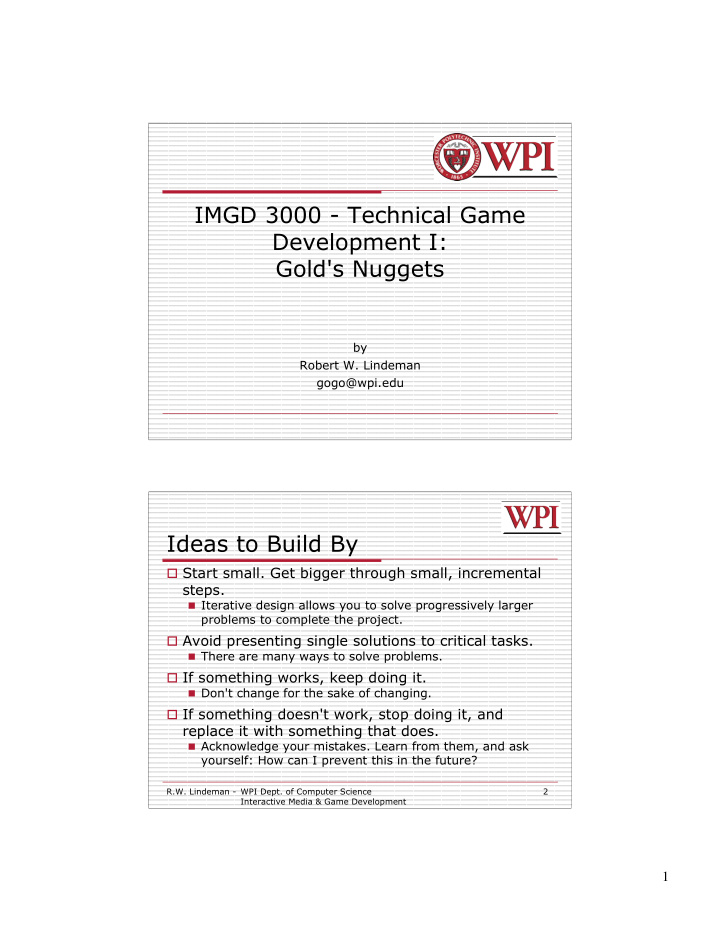



IMGD 3000 - Technical Game Development I: Gold's Nuggets by Robert W. Lindeman gogo@wpi.edu Ideas to Build By Start small. Get bigger through small, incremental steps. Iterative design allows you to solve progressively larger problems to complete the project. Avoid presenting single solutions to critical tasks. There are many ways to solve problems. If something works, keep doing it. Don't change for the sake of changing. If something doesn't work, stop doing it, and replace it with something that does. Acknowledge your mistakes. Learn from them, and ask yourself: How can I prevent this in the future? R.W. Lindeman - WPI Dept. of Computer Science 2 Interactive Media & Game Development 1
Ideas to Build By (cont.) Avoid repeating things you do wrong, and void having to redo things you've already done right. Reuse what you can. Better yet, make your design (and write your code) knowing you will use it again on a different problem. No rule, no matter how good, is applicable in every situation. You should use whatever languages/tools/environments/people make the most sense for the given situation. R.W. Lindeman - WPI Dept. of Computer Science 3 Interactive Media & Game Development Phases of Learning Unconscious Incompetence "I didn’t even know I couldn't do it." Conscious Incompetence "I'm aware it's not how I'd like it to be." Conscious Competence "If I make the effort, I can get the desired result." Unconscious Competence "I don't even have to try and it works out." R.W. Lindeman - WPI Dept. of Computer Science 4 Interactive Media & Game Development 2
Development Priorities What are some priorities for measuring the quality of games? Where should you spend most of your time/effort? How would you order these? R.W. Lindeman - WPI Dept. of Computer Science 5 Interactive Media & Game Development Reality of Game Dev: Open-Ended Development CORE REQUIRED DESIRED R.W. Lindeman - WPI Dept. of Computer Science 6 Interactive Media & Game Development 3
Reality of Game Dev: Heuristic Content Constantly making "playjustments" Incremental tweaking of game-play elements to make a game more playable, balanced, etc. Subjective, so test with players! Eye candy versus substance R.W. Lindeman - WPI Dept. of Computer Science 7 Interactive Media & Game Development Reality of Game Dev: Hardware Hardware support Lowest common denominator PC? Console? Handheld? Control methods Specialty controller Guitar WASD + Mouse? Camera input? EyeToy Motion-sensitive controller? Wii/PS3 R.W. Lindeman - WPI Dept. of Computer Science 8 Interactive Media & Game Development 4
Game Software Engineering Games are getting more sophisticated Development times are not getting longer Team sizes are growing only modestly Various companies/groups involved Need to be more efficient in development Reduce time scales Use team members better Problems Egos, inertia, structure, ... R.W. Lindeman - WPI Dept. of Computer Science 9 Interactive Media & Game Development What Makes a Good Game Developer? Good programmer? Language specific? Designer and planner Bottom-up and top-down analyses Estimator and scheduler Team player Liaise with artists Follow a lead developer Support other developers Technical reviews R.W. Lindeman - WPI Dept. of Computer Science 10 Interactive Media & Game Development 5
Recommend
More recommend